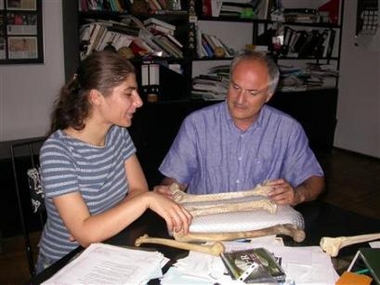Human ancestor had mix of primitive, modern traits
Updated: 2007-09-20 07:59
WASHINGTON - The earliest-known human ancestors to migrate out of Africa possessed a surprising mix of human-like and primitive features, according to scientists who studied remains dug up at a fossil-rich site in the former Soviet republic of Georgia.
 This undated handout photograph shows scientists David Lordkipanidze and Tea Jashashvili with remains of early human ancestors excavated at a site in the nation of Georgia. [Reuters] |
Writing on Wednesday in the journal Nature, the scientists described remains of three adults and one adolescent dating from about 1.77 million years ago, excavated at Dmanisi, about 55 miles southwest of the Georgian capital, Tbilisi.
The remains shed light on a little-understood but critical period in human evolution -- the transition from the more ape-like creatures known as australopithecines to the genus Homo, of which modern humans are a member.
The spines and lower limbs found at the Dmanisi site appear very much like modern humans, suggesting these individuals, which walked fully upright, were highly capable of long-distance treks, the researchers said.
But other aspects of the skeletons had more archaic characteristics. The arms were more like australopithecines than people, and the primitive skulls encased relatively small brains. Their simple stone tools also are less advanced than one might have expected, the researchers said.
They described the remains as "a surprising mosaic" of primitive and modern features.
"These are the earliest humans found outside of Africa. This is the time when our genus spread outside of Africa," David Lordkipanidze of the Georgian National Museum, who led the research, said in a telephone interview. "Their heads are primitive. Their legs are very human-like."
Scientists had previously described skulls found at the site, but in recent years found far more extensive remains of the skeletons of these creatures, giving them a more detailed understanding of these denizens of early human history.
Danger Lurks
Also found at the site were remains of other animals that lived alongside these human ancestors, including saber-toothed cats that might have feasted on these human ancestors, primitive elephants, ostriches and giraffes.
Evidence at the site, the researchers said, suggested that these creatures were meat eaters, either hunting for their dinner or scavenging carcasses killed by other animals. They were relatively small, about 4.9 feet tall.
The paleontological site at Dmanisi was found during explorations at the ruins of a medieval castle in the 1990s.
There is a dispute over what species these individuals represent -- whether, for example, they are a very primitive member of Homo erectus or their own new species.
"Before these finds, it was considered that the humans who left Africa should have had completely human-like bodies, more human-like proportions and bigger brains," Lordkipanidze said.
Harvard University anthropologist Daniel Lieberman, who wrote a commentary accompanying the study, said the human evolutionary events unfolding at about the time these individuals lived were very important.
"We go from creatures that essentially were chimps that walked upright to creatures that begin to be like us," Lieberman said in a telephone interview.
"That transition to our genus didn't occur really rapidly, all of a sudden, in one great huge burst," he added. "Instead, that transformation was more gradual."
|
|
|
||
|
||
|
|
|
|